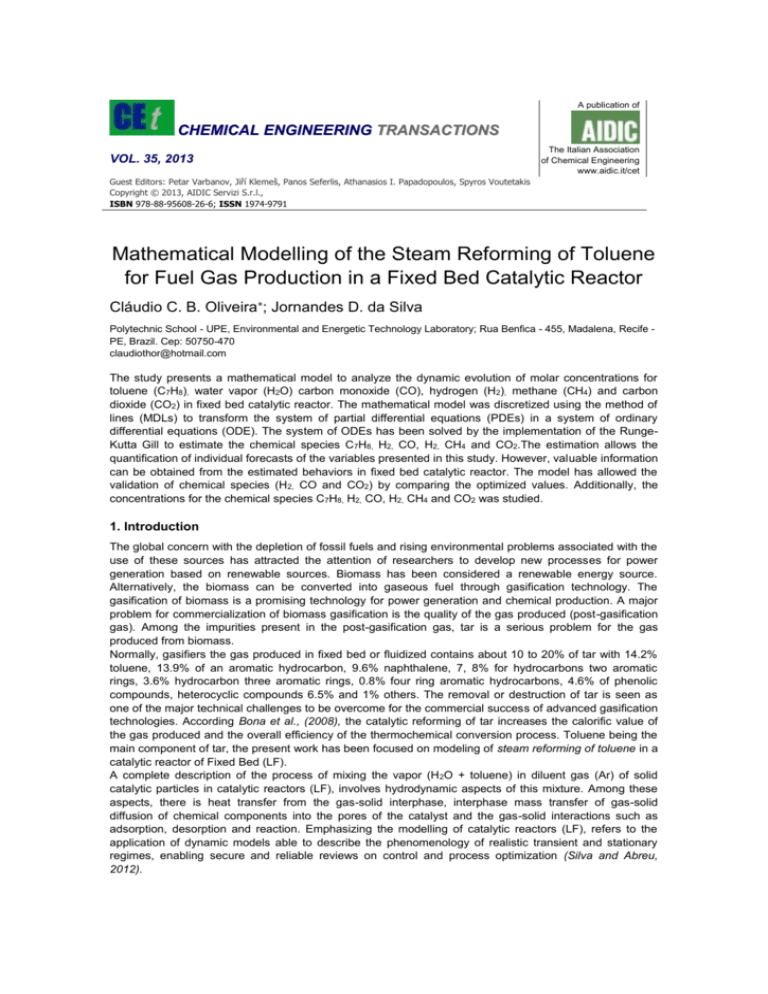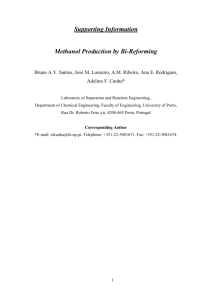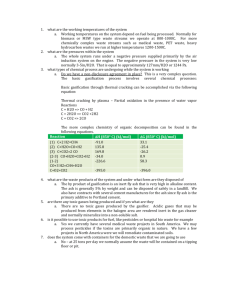Format And Type Fonts
advertisement

A publication of CHEMICAL ENGINEERING TRANSACTIONS VOL. 35, 2013 The Italian Association of Chemical Engineering www.aidic.it/cet Guest Editors: Petar Varbanov, Jiří Klemeš, Panos Seferlis, Athanasios I. Papadopoulos, Spyros Voutetakis Copyright © 2013, AIDIC Servizi S.r.l., ISBN 978-88-95608-26-6; ISSN 1974-9791 Mathematical Modelling of the Steam Reforming of Toluene for Fuel Gas Production in a Fixed Bed Catalytic Reactor Cláudio C. B. Oliveira; Jornandes D. da Silva Polytechnic School - UPE, Environmental and Energetic Technology Laboratory; Rua Benfica - 455, Madalena, Recife PE, Brazil. Cep: 50750-470 claudiothor@hotmail.com The study presents a mathematical model to analyze the dynamic evolution of molar concentrations for toluene (C7H8), water vapor (H2O) carbon monoxide (CO), hydrogen (H2), methane (CH4) and carbon dioxide (CO2) in fixed bed catalytic reactor. The mathematical model was discretized using the method of lines (MDLs) to transform the system of partial differential equations (PDEs) in a system of ordinary differential equations (ODE). The system of ODEs has been solved by the implementation of the RungeKutta Gill to estimate the chemical species C7H8, H2, CO, H2, CH4 and CO2.The estimation allows the quantification of individual forecasts of the variables presented in this study. However, valuable information can be obtained from the estimated behaviors in fixed bed catalytic reactor. The model has allowed the validation of chemical species (H2, CO and CO2) by comparing the optimized values. Additionally, the concentrations for the chemical species C7H8, H2, CO, H2, CH4 and CO2 was studied. 1. Introduction The global concern with the depletion of fossil fuels and rising environmental problems associated with the use of these sources has attracted the attention of researchers to develop new processes for power generation based on renewable sources. Biomass has been considered a renewable energy source. Alternatively, the biomass can be converted into gaseous fuel through gasification technology. The gasification of biomass is a promising technology for power generation and chemical production. A major problem for commercialization of biomass gasification is the quality of the gas produced (post-gasification gas). Among the impurities present in the post-gasification gas, tar is a serious problem for the gas produced from biomass. Normally, gasifiers the gas produced in fixed bed or fluidized contains about 10 to 20% of tar with 14.2% toluene, 13.9% of an aromatic hydrocarbon, 9.6% naphthalene, 7, 8% for hydrocarbons two aromatic rings, 3.6% hydrocarbon three aromatic rings, 0.8% four ring aromatic hydrocarbons, 4.6% of phenolic compounds, heterocyclic compounds 6.5% and 1% others. The removal or destruction of tar is seen as one of the major technical challenges to be overcome for the commercial success of advanced gasification technologies. According Bona et al., (2008), the catalytic reforming of tar increases the calorific value of the gas produced and the overall efficiency of the thermochemical conversion process. Toluene being the main component of tar, the present work has been focused on modeling of steam reforming of toluene in a catalytic reactor of Fixed Bed (LF). A complete description of the process of mixing the vapor (H 2O + toluene) in diluent gas (Ar) of solid catalytic particles in catalytic reactors (LF), involves hydrodynamic aspects of this mixture. Among these aspects, there is heat transfer from the gas-solid interphase, interphase mass transfer of gas-solid diffusion of chemical components into the pores of the catalyst and the gas-solid interactions such as adsorption, desorption and reaction. Emphasizing the modelling of catalytic reactors (LF), refers to the application of dynamic models able to describe the phenomenology of realistic transient and stationary regimes, enabling secure and reliable reviews on control and process optimization (Silva and Abreu, 2012). The mathematical modelling and computer simulation for catalytic reactors (LF) are in continuous development, aiming to improve knowledge of the phenomenological processes of this equipment. As its applications, catalytic reactors (LF) are applied in the process of the chemical, biochemical, petrochemical and oil refineries to process hydrodesulfurization, hydrotreatment and hydrocracking (Silva, 2012). The main objective of this paper was the development of a dynamic mathematical model to study isothermal steam reforming of toluene in a catalytic reactor (LF). The model has allowed a validation of chemical species (H2, CO and CO2) by comparing the optimized values. Additionally, the net rates of the chemical species C7H8, H2, CO, H2, CH4 were studied as well as the concentrations for the chemical species C7H8, H2, CO, H2, CH4 and CO2. 1.1 Kinetic mechanism for this search The kinetic models treat the mechanisms, rates of chemical reactions and the resulting concentrations of species at any point in time and space of a system. These models are generally related to specific processes, providing important considerations relating to the mechanisms of reactions and ways to increase the rate of a reaction or process. The process discussed here has involved the main reactions of steam reforming of toluene. In normal operation, the reaction (I) is the steam reforming of toluene, the reaction (II) presents the partial steam reforming reaction of methane and (III) shows the reaction gas Shift. Reaction (I) is an irreversible reaction, while reactions (II) and (III) are reversible (equilibrium) as follows. 0 1 C7 H8 7 H2O 7CO 11H2 ; H298 K 869,17 kJ mol (1) 0 1 CH4 H2O CO 3H2 ; H298 K 206 ,12 kJ mol (2) 0 1 CO H2O CO2 H2 ; H298 K 41,17 kJ mol (3) Thermodynamically, reactions (I) and (II) are endothermic and enough diet (III) is exothermic. The components of these reactions models are defined as toluene (C 7H8), water (H2O), carbon monoxide (CO), hydrogen (H2), methane (CH4) and carbon dioxide (CO2). The stoichiometric coefficients for these components models have been presented in Table (1). Table 1: Stoichiometric coefficients ij of the components of the reactions Reactions 1 2 3 C7H8 -1 0 0 H2O -7 -1 -1 CO +7 +1 -1 H2 +11 +3 +1 CH4 0 -1 0 CO2 0 0 +1 1.2 Mathematical Modeling Study on Kinetic Process The kinetic mathematical model presented here considers only three homogeneous reactions according to the reactions (I), (II) and (III) for the reform of toluene. The overall rates for chemical reactions (1), (2) and (3) are presented below with their respective kinetic parameters. R1 8.723 x10 9 CC7 H 8 ; kgcat s 1 15.000 R2 3.101 exp Tg CCO C H2 2 C ; kg s 1 CH 4 C H 2 O cat 32.900 0.0265 exp Tg (4) (5) 138.000 C C CO 2 H 2 C C ; kg s 1 R3 250.000 exp (6) CO H O cat 2 T g 3966.000 0.0265 exp Tg The rates of liquid intake and training, ri, for each component type of the reactions (I), (II) and (III) have been obtained using the following equation (Xiu et al, 2002). n ri j 1 ij Rj (7) Where, ri net rate of component I, ij stoichiometric coefficient of the reaction and R j Reaction rate. From the Equation (7), we get to obtain rC7 H 8 , rH 2O , rCO , rH 2 , rCH 4 and rCO2 as fallow: -net rate of C7H8; rC7 H 8 R1 (8) -net rate of H2O; rH 2O 7 R1 R2 R3 (9) -net rate of CO; rCO 7 R1 R2 R3 (10) -net rate of H2; rH 2 11R1 3R2 R3 (11) -net rate of CH4; rCH 4 R2 (12) -net rate of CO2; rCO2 R3 (13) 2. Simplified Mathematical Model for a Catalytic Reactor The mathematical modelling can act significantly to explain the evolution of model components of chemical reactions (1), (2) and (3) in catalytic reactor (LF). For this work, the equations of the model components involved terms of chemical species accumulation, convection of chemical species, dispersions of chemical species and the rates of component templates in reactions considered for the process. Based on these assumptions, a simplified mathematical model for LF is formulated by the simplified equations of model components which describe the dynamic behavior. In the reaction zone of the LF, the mass balance equations of the components of the reactions (1), (2) and (3) (reactants and products) have been described in the following sequence C7H8, H2O, CO, H2, CH4 and CO2 as follows. - Mass balance of the model components 3 1 s j ri j 1 t d c2 z z 2 - Initial and boundary conditions of the model components; Ci t 0 Ci ,0 ; for all z g Di Ci g Ci z z 0 Ci z 4 Qg Ci g Di 4 Qg C i d c2 z 0 2Ci Ci ,0 ; for t 0 (10) (11) (12) 0 ; for t 0 (13) z L 3 Where i = C7H8, H2O, CO, H2, CH4 and CO2; j , j = 1, 2 and 3 (reactions) j 1 3. Results The mathematical model developed for the LF led to the behavior of process variables for this reactor. The model was developed to analyze the molar concentrations of chemical species for C7H8, H2O, CO, H2, CH4 and CO2. The proposed model for this study was used to analyze the evolution of chemical species over time variable (t) at the output of this reactor. It was also used a sensitivity study using the molar ratio (m). In the simulation of the process variables studied, the computer code has been supplied with parameters shown in Table (2). In this table, it was shown the operational parameters in the reaction region of the LF mass transfer coefficients and physical properties of the gaseous phase. The parameters of Table (2) have been admitted as fixed values. Table 2: Input values of operating conditions, properties of the gas and solid phases used in the simulation (Silva, 2012; Zhao et al, 2010; Yao et al. 2007) Categories Operation Conditions Properties Operation temperature of the gas phase, TgoC Operation temperature of the solid phase, TsoC Operation pressure, Pop atm Gas flow rate, Qg m3 s-1 Flow of water vapor, Qv m3 s-1 Initial concentration of C7H8, CC7H8,0 kg m-3 Initial concentration of H2O, CH2O,0 kg m-3 Initial concentration of CO, CCO,0 kg m-3 Initial concentration of H2, CH2,0 kg m-3 Initial concentration of CH4, CCH4,0 kg m-3 Initial concentration of CO2, CCO2,0 kg m-3 Catalytic reactor diameter, dr m Gas properties Void fraction of the gaseous phase, g (-) Density of the gaseous phase, g kg m-3 Diffusion coefficient of C7H8, DC7H8 m2 s-1 Diffusion coefficient of H2O, DH2O m2 s-1 Diffusion coefficient of CO, DCO m2 s-1 Diffusion coefficient of H2, DH2 m2 s-1 Diffusion coefficient of CH4, DCH4 m2 s-1 Diffusion coefficient for CO2, DCO2 m2 s-1 Properties of the solid phase Void fraction of the solid phase, s (-) Density of the solid phase, s kg m-3 Solid particle diameter, dp m Heat of reactions andHeat of reaction for reaction (1), Hr,1 850oC, kJ mol-1 effectiveness factor Heat of reaction for reaction (2), Hr,2 850oC, kJ mol-1 Heat of reaction for reaction (3), Hr,3 850oC, kJ mol-1 Effectiveness factor of reaction (1), 1 Effectiveness factor of reaction (2), 2 Effectiveness factor of reaction (3), 3 Numerical Values 400 400 1.011 2.367x10-2 2.561x10-4 0.145 0.052 0.000 0.000 0.100 0.000 0.032 0.360 0.0756 1.571x10-5 2.113x10-5 1.567x10-5 6.915x10-6 3.337x10-5 8.987x10-6 0.614 1.250x103 0.00046 + 639.291x103 + 206.191x103 - 89.231x10x103 0.067 0.073 0.573 0.20 rH 0.16 2 -3 -1 ri (kg m s ) 0.12 0.08 rCO rCO 0.04 2 rH O 2 0.00 rCH 4 -0.04 rC H 7 8 -0.08 0 20 40 60 80 100 Time (sec) Figure1: Profiles of net chemical species for C7H8, H2O, CO, H2, CH4, CO2 versus the time variable in the output of the LF: z = 1m, Qg = 2.367 x10-2 m3 s-1, Qv = 2.561 x 10-2 m3 s-1, Tg = 400oC and Ts = 400oC 0.70 H2 Comp. of optimized H2 of this work Comp. of obtained H2 by Zhao et al. (2010) Comp. of optimized CO of this work Comp. of obtained CO by Zhao et al. (2010) Comp. of optimized CO2 of this work Comp. of obtained CO2 by Zhao et al. (2010) m = 2,00 CO Conc. of Gas (H2, CO, CO2) 0.56 0.42 0.28 0.14 CO2 0.00 700 750 800 850 900 950 o Temperature ( C) Figure 2: Comparison between experimental data of Zhao et al. and the results of this study optimized for four temperatures with Qg = 2.367 x10-2 m3 s-1, Qv = 2.561 x 10-2 m3 s-1 0.15 CCO 0.12 CC H 8 CH -3 Ci(kg m ) 7 0.09 0.06 2 CCH 4 CCO 0.03 2 CH O 2 0.00 0 20 40 60 80 100 Time (sec.) Figure 3: Profiles of the concentrations of chemical species H 2, CO, CO2, C7 H8, CH4 e H2O time variable at the output of LF under the following conditions: z = 1m, Qg = 2.367 x 10 -2 m3 s-1, Tg = 400oC, Ts = 400oC and at = 8 sec. of computer time. Figure 1 shows the net rates of each chemical species relative to the time variable at the output of the LF. The net rates rH2, rCO, rCO2 reported an increase between 0.00 sec. to 100 sec. due to increased production of chemical species H2, CO and CO2 800C. The net rates rC7H8, rCH4 and rH2O suffer because of decreasing consumption of chemical species C7H8,CH4 and H2O at 800oC. Figure 2 shows the comparative experimental data of the literature and data of the present study optimized. The comparison shows a good fit of the experimental and optimized for the gases H 2, CO and CO2. Figure 3 reports the evolution of C7 H8, H2O, CO, H2, CH4, and CO2 versus the time variable in the exit of the LF. Chemical species CO, CO2 and H2 are produced from the initial values of CCO = 0.00, CH2 = 0.00 and CCO2 = 0.00 until reaching a maximum value at the operating conditions adopted, while chemical species C7H8, H2O and CH4 have been consumed from the initial values YC7H8 = 0.148, YH2O = 0.052 and YCH4 = 0.101. The chemical species H2 and CO in 80 sec. reached steady state, while the chemical species CO2 reached a maximum and then decreases reaching a steady state at 70 sec. Regarding chemical species C7H8, H2O and CH4, it is observed that they were completely between (40-60) sec. 4. Conclusions Conducted in the context of reform of the line of aromatic components, this research will resort numerical methodology in order to carry out the development process in isothermal catalytic reactor operating dynamics of LF. In conditions allowed for this research, the method of Range-Kutta Gill was used to predict a chemical species H2, CO, CO2, C7 H8, CH4 e H2O. The development of computer code to process and analyze the behavior of the variables in this research allowed the lead the following conclusions: - The net rates (rC7H8, rH2O, rCO, rH2, rCH4 and rCO2) of each chemical species were calculated. Since the net rates rCO, rH2 and rCO2 showed increase, while the net rates rC7H8, rCH4 and rH2O reported a decrease versus the time variable; - The model developed for the LF led to calculations of optimized concentrations of chemical species H 2, CO and CO2, validation confirmed by comparing the results of this research and the results obtained by Zhao et al., (2010); - Consumption and production has shown of chemical species C 7H8, H2, CO, H2, CH4, and CO2 in a LF versus time variable; Acknowledgments The authors of this paper would like to thank CNPQ (National Council of Scientific and Technological Development) for the financial support given. (Process 48354 / 2007). References Bona, S., Guillén, P. J., Alcalte, G., García, L., Bilbao, R. 2008, Toluene Steam Reforming Using Coprecipitated Ni/Al Catalysts Modified with Lanthanum or Cobalt, Chemical Engineering Journal, 137, 587-597. Silva, J. D., Abreu, C. A. M., 2012, Mathematical modeling of a three-phase trickle bed reactor. Braz. J. Chem. Eng., 29, 3, 567-576 .doi:10.1590/S0104-66322012000300014. Silva, J. D.,2012, Dynamic Modelling for a trickle-bed reactor using the numerical inverse Laplace transform technique. Procedia Engineering., 42, 454-470. doi: 10.1016/j.proeng.2012.07.437 Xiu, G.; Li, P.; Rodrigues, A. E.,2002, New Generalized for improving sorption-enhanced reaction process, Chemical Engineering Science, 58, 3425-3437. Yao B. Y.; Anh N. P., Changkook R.; Vida S.; Jim S., 2007, Mathematical modelling of slow pyrolysis of segregated solid wastes in a packed-bed pyrolyser. Fuel, 86, 169-180. Zhao, B.; Zhang, X.; Chem, L.; Qu. R.; Meng, G.; Yi, X.; Sun, L., 2010, Steam Reforming of Toluene as Model Compound of Biomass Pyrolysis Tar for Hydrogen. Biomass and Bioenergy, 34, 140-144.







